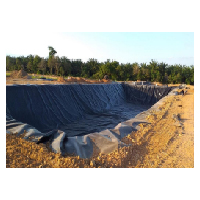Information
High-density polyethylene (HDPE) geomembranes and low-density polyethylene (LDPE) geomembranes are used in different applications due to their unique physical and chemical properties.
HDPE Geomembranes:
These are suitable for applications requiring higher tensile strength, puncture resistance, abrasion resistance, and greater dimensional stability. They are commonly used in liquid and gas containment applications such as landfills, retention ponds, storage tanks, and canals.
LDPE Geomembranes:
These are more flexible and have lower tensile strength and puncture resistance compared to HDPE geomembranes. Due to their flexibility, they are more suitable for applications requiring greater deformation capacity, such as canal liners or liners for wastewater treatment lagoons.
The choice between HDPE and LDPE geomembranes depends on the specific conditions of each project, including load and chemical resistance, soil characteristics, climate, and design and operational requirements.
Smooth vs. Textured Geomembranes:
The main difference between smooth and textured polyethylene geomembranes lies in their surface.
-
Smooth Polyethylene Geomembranes:
These have a smooth and flat surface without any texture or pattern. They are suitable for applications requiring a uniform and smooth contact surface, such as liquid and gas containment in landfills, retention ponds, and canals.
-
Textured Polyethylene Geomembranes:
These have a surface with patterns or textures, such as a series of small conical protrusions. These protrusions can vary in height and distribution and are designed to increase friction between the geomembrane and the soil layer or geotextile layer placed over it. This improves the stability and grip of the geomembrane and can be especially useful on slopes or in looser or unstable soils. Textured geomembranes can also have anti-slip and drainage properties.
The choice between a smooth or textured geomembrane depends on the specific project conditions and design requirements.
Geomembrana negra de polietileno de baja densidad (LLDPE) fabricada a base de polímero.
Funciones y Beneficios
La resina del polietileno esta diseñada específicamente para usos flexibles de geomembrana. Sus altas características uniaxiales y multiaxiales del alargamiento son muy convenientes para cualquier uso donde la resistencia de alargamiento o de la pintura sea crítica.
Usos
Sellado de celdas en rellenos sanitarios para manejo de desechos domésticos e industriales.
Colectores de agua potable, agua de drenaje y agua contaminada.
Camas de lixiviación en minas.
Sistemas de sellado en túneles, lagunas artificiales y sistemas de contención secundaria en industria.
Características
Disponible desde 0.5 hasta 2.5 mm
Lisa y rugosa
- Marca: Soldaplas
- Aplicación: Geomembranas








